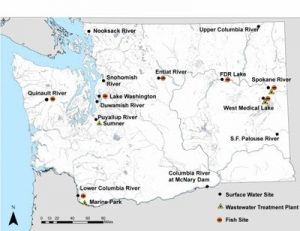Editor’s Note: This is the second installment in a series of posts delving into some of the the chemical pollutants that have contaminated Puget Sound’s fish and wildlife and pose one of the greatest threats to their survival. This is part one of a two-part series, A Non-Sticky Situation, that examines perfluoinated compounds or “Teflon chemicals,” found in everything from non-stick cookware to stain-resistant carpeting.
It’s raining Teflon. Perfluorinated compounds, otherwise known as “Teflon chemicals,” have become so widespread in the environment that they’re raining down on us throughout North America[1]. And according to new tests, they also contaminate the waters and sediment of Puget Sound, local rivers and lakes, and fish and wildlife.
As their nickname implies, the perfluorinated compounds, or PFCs, are responsible for the miracle of nonstick pans. With their unique ability to repel both oil and water, however, their popularity now extends to fabric treatments, carpet treatments, paper coatings, and a multitude of other products—in each case, performing powerfully as stain repellants[2].
But these compounds are special in other ways. They’re really a family of chemicals, each based on a common chemical structure using fluorine. This structure provides the miracle of nonstick, but this extra-strong chemical makeup also makes them practically bombproof. In fact, the two most commonly detected PFCs, known by their acronyms PFOA and PFOS, have estimated half-lives in the human body of four and eight years, respectively. In people, these long-lived chemicals are linked to cancer, liver damage, and thyroid effects[2].
With their extraordinary ability to persist, PFCs have been detected not only in rain but also in ice caps, soils, air, surface water, and sewage sludge[2]. Wildlife around the world, including mink, bottle-nosed dolphins, polar bears, seals, cormorants, and ospreys have tested positive. So have large-mouth bass from the Columbia River, yellow perch from Lake Washington, and rainbow trout from West Medical Lake near Spokane[3]. In a number of these species, tests over time have found levels increasing at exponential rates: in Canadian polar bears, for example, the most recent tests found levels ten times those detected in the 1970s.[4]

Besides being persistent, PFCs have a knack for mystery. The most persistent members, PFOA and PFOS, serve as processing aids in manufacturing and are not supposed to turn up in the final product. Since they weren’t thought to be escaping from products, common belief has held that these compounds enter the environment primarily as waste from manufacturing facilities[5]. But new research, started by a group at the University of Toronto, is telling a different story.
The mystery began when scientists started to find PFCs in the Arctic—in the air, in the ice, and in wildlife. And they were finding them in quantities greater than could be expected from travel from manufacturing regions via ocean currents. That’s when Dr. Scott Mabury’s group in Toronto started looking at the PFCs that are present in consumer products, and whether they could be responsible for the widespread global contamination problem.
Mabury’s group tested the stain-protection products made with PFC chemistry, such as 3M’s Scotchgard, Dupont’s Zonyl, and other products available directly to consumers. What they found is that these products do contain residual amounts of building block chemicals known as telomere alcohols[6]. Unlike PFOA and PFOS, the telomer alcohols have the ability to travel in the atmosphere, making them a likely candidate for the culprit behind global contamination, including in the polar regions. What’s more, they have shown that these building block chemicals degrade into PFOA and PFOS, the family members that are most persistent and therefore of the greatest concern.
Map courtesy of the Washington State Department of Ecology.
Notes:
- Scott, B., C Spencer, SA Mabury, and DCG Muir, Poly and perfluorinated carboxylates in North American Precipitation. Environmental Science and Technology, 2006. 40(23): p. 7167-7174.
- Lau, C., K Anitole, C Lodes, D Lai, A Pfahles-Hutchens, and J Seed, Perfluoroalkyl acids: a review of monitoring and toxicological findings. Toxicological Sciences, 2007. 99(2): p. 366-394.
- Furl, C., and C Meredith, Perfluorinated compounds in Washington rivers and lakes. 2010, Toxic Studies Unit, Environmental Assessment Program, Washington State Department of Ecology: Olympia.
- Houde, M., JW Martin, RJ Fletcher, KR Solomon, and DCG Muir, Biological monitoring of polyfluoroalkyl substances: a review. Environmental Science and Technology, 2006. 40(11): p. 3463-3473.
- Prevedouros, K., IT Cousins, RC Buck, and SH Korzeniowski, Sources, fate, and transport of perfluorocarboxylates. Environmental Science and Technology, 2006. 40(1): p. 32-44.
- Dinglasan-Panlilio, M., and SA Maybury, Significant residual fluorinated alcohols present in various fluorinated materials. Environmental Science and Technology, 2006. 40(5):p. 1447-1453.




